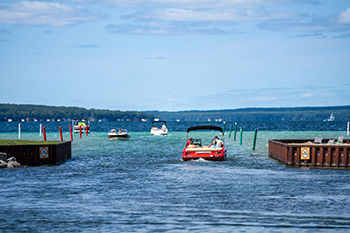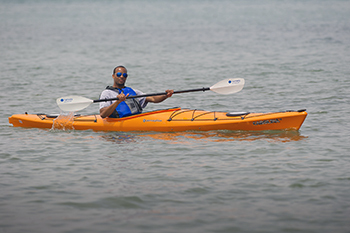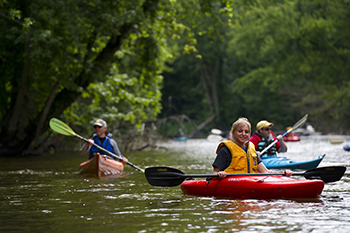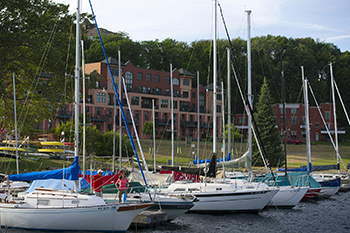Celebrating 75 years of making boating better
Michigan State Waterways Commission – yesterday, today and tomorrow
By MAIA TUREK
Engagement and Innovation Specialist
Michigan Department of Natural Resources
Boating has been a human pursuit for at least 8,000 years, with waters beckoning us toward adventure, providing food and helping build cities and economies for millennia.
Those motivations for taking to the water have persisted and still ring true today. Boating is part of us.
In 2022, Michigan celebrates the 75th anniversary of boating our waterways the way we enjoy it today – a modern concept involving the access and infrastructure needed for boating; launches, marinas, gas docks, locks and dams and the maintenance to keep these destinations accessible and operational.

The Michigan State Waterways Commission, a seven-member advisory commission appointed by the governor, was created in 1947 to advise on how to place, fund and manage harbors to provide safe, navigable boating on Michigan’s Great Lakes.
The commission has evolved significantly since its early charge and today is looking toward the future of boating to ensure Michigan continues to be a world-class freshwater boating destination.
The evolution of recreational boating
Established by the Michigan Legislature, the Michigan State Waterways Commission was created to take advantage of federal monies made available from the 1945 Rivers and Harbors Act, which provided funding for U.S. Army Corps of Engineers projects on the nation’s navigable waters.
Michigan soon began to create a safe harbor of refuge network on the state’s Great Lakes shoreline. This included the funding for protective breakwater structures and harbor basin and channel dredging to establish many of the harbors we know today, as well as routine maintenance dredging responsibilities for which the state, in turn, would provide mooring facilities.
This plan began Michigan’s Waterways Program.
|

By 1949, the state began additional efforts to expand the harbor of refuge network by collaborating with local units of government (counties, townships and cities) in the construction, maintenance and operation of these facilities. This started what is known today as the Grant-in-Aid Program, establishing federal, state and local partnerships in the development of Great Lakes harbor facilities.
In 1966, when the new state constitution went into effect, the functions of the commission became a part of the Michigan Department of Conservation – the precursor to the Michigan Department of Natural Resources – and grew to add responsibility for selecting and creating boating access sites, or boat launches, on Michigan’s abundant inland lakes as well.
Funding to meet the needs of Michigan’s boaters became a priority, which is how Michigan became the first state in the nation to establish a state marine fuel tax. This carved out a portion of the state tax on the sale of gasoline for a fund that helps to provide boaters access to Michigan’s waters.
In addition to the Grant-In-Aid Program, the federal government supports the harbor program through funds allocated to the Dingell-Johnson Fund, administered by the U.S. Fish and Wildlife Service for the development of boating facilities designed to match local contributions.
|

The U.S. Army Corps of Engineers played an important role in the initial development and actual construction of the majority of Michigan's harbor network. The federal/state/local program of cooperation is aimed primarily at the development of facilities.
Responsibility for continuing operation and maintenance lies with local communities, and so reasonable fees are charged for the upkeep and operation of docks and piers, showers, restrooms and other facilities at these harbors.
Only where local resources are unable to support such facilities does the state consider assuming these responsibilities. As a result, the state of Michigan operates only 18 of Michigan's harbor facilities.
The Army Corps oversees harbors of refuge.
Michigan more than a “Mitten”
Michigan is often called the “Mitten State” in reference to the shape of the Lower Peninsula, but those who have had the opportunity to experience the state from the water understand the full story of why Michigan’s maritime heritage is so important.
From the early Native Americans and French fur traders to shipments of lumber that helped rebuild Chicago, water has defined much of what Michigan is.
|

Today recreational boating contributes $7.8 billion annually to Michigan’s economy and supports 60,000 jobs.
The DNR, Michigan State Waterways Commission and community partners have ushered in a network of 84 protective harbors and public marinas for the convenience and safety of Great Lakes boaters. To date, there are more than 1,300 public boating access sites, developed and undeveloped.
These places are more than just where you put your boat into a river or lake – they are destinations for people to explore all corners of Michigan from the water. They are a passageway to hours spent enjoying the calm and quiet of the water, to the memories made with family and friends while floating, tubing, paddling, cruising or sailing. They make over-water sunrises and sunsets available to everyone, not just the few who can afford waterfront property.
“I believe the most noble responsibility of the commission is to make sure that all people, regardless of their income level, abilities, or ethnicity have access to our Freshwater resources,” said Fred Sitkins, executive director of the Inland Seas Education Association in Suttons Bay and a Waterways commissioner since 2021.
|

Boating is arguably Michigan’s pastime, with the state having the third-largest number of registered boats in the country and is often a heritage sport passed down from generation to generation.
Since the onset of the COVID-19 pandemic, thousands of new boaters have discovered the safety, affordability and wellness benefits that come with boating.
While it’s easy to assume that boaters are only people who actually own boats, waterways have helped expand that definition in many ways, including creating opportunities for businesses.
For example, fishing charters and boat rentals use these public boating access sites and marinas to make boating available to others who want to experience it.
Many boat manufacturers and dealerships also use boating access sites and marinas for classes and demo days to offer anyone interested in boating the opportunity to try it.
Many state parks also offer boat rentals and boating programs.
The Michigan Boating Industries Association and Boat Michigan have been welcoming new boaters aboard for years with the Discover Boating campaign.
|

To experience boating before making the commitment to purchase your own boat, consider renting a boat or joining a boat club like Freedom Boat Club for shared ownership. Both options are growing in popularity at marinas around the state.
The future of boating
After 75 years of improving boating access, the Waterways Commission and the industry began to address additional challenges facing the sustainability of boating.
In 2019, in collaboration with the commission, the DNR invested in a consultant to analyze infrastructure needs for the next 20 years. The study found that the boating program faces over $755 million in baseline improvement needs and a $26.8 million shortfall annually to keep pace with this need.
Innovative thinking, understanding trends and required modernization of facilities, and looking at new funding models are all topics on the agenda for the DNR and commission, as well as evaluating current funding sources to ensure a sustainable future for the boating access Michiganders have come to expect.
Also, climate change and associated environmental threats, such as high water, severe weather events and aquatic invasive species are all topics that current and future commissioners will be challenged to overcome with the help and support of Michigan’s boaters.
“We all need to keep our waters clean and protected from invasive species and help make provisions to keep boating access sites, marinas and harbors safe and relevant to modern needs of boaters,” said Mary Rising, vice chair of the Waterways Commission and office manager for Action Water Sports in Fenton.
There is also a new challenge the commission and the boating industry are striving to address.
|

According to the Rhode Island Marine Trades Association, between 2003 and 2019, an estimated 3 million recreational boats were retired in the United States. This rate of accumulation is not expected to slow down, as many first-generation fiberglass boats launched in the 1970s-1990s have begun to reach their end-of-life status without a sustainable option for disposal.
Michigan is tackling this problem with a multi-industry team, striving to make the state the leader in fiberglass recycling – and not just for boats, but for construction, manufacturing, energy and other industries that currently use fiberglass.
Michiganders are known for being makers, yet this initiative could firmly cement the state’s workers as the “re-makers” of fiberglass.
Individuals, businesses and organizations can also share thoughts and ideas related to fiberglass boat recycling and sign up to be kept in the loop on this initiative.
How can you get involved?
With so much happening in boating right now, there are many ways for citizens to have their voice heard. Learn more about the Waterways Commission online, including reviewing past meeting information and upcoming meeting schedules.
The DNR encourages boaters to attend these public meetings to share any thoughts they might have related to public boating access and its infrastructure, or the sustainability of boating.
Those who are very passionate about boating can apply to become a waterways commissioner through the governor’s appointment process.
Or, if you just want some great boating destination ideas, freshwater facts and ideas for celebrating 75 years of Michigan boating, text the word “Water” to 80888 to sign up for weekly Water Wednesday text updates from the DNR through Sept. 7.
No matter what you do, this is the summer to grab your friends, family and something that floats and find your way to the water. Find ideas for how to celebrate the 75th anniversary of the Michigan State Waterways Commission at Michigan.gov/Boating.
|
Check out previous Showcasing the DNR stories in our archive at Michigan.gov/DNRStories. To subscribe to upcoming Showcasing articles, sign up for free email delivery at Michigan.gov/DNR.
Note to editors: Contact: John Pepin, Showcasing the DNR series editor, 906-226-1352. Accompanying photos and a text-only version of this story are available below for download. Caption information follows. Credit Michigan Department of Natural Resources, unless otherwise noted.
Text-only Version of this story.
Belle Isle: Belle Isle Park in Detroit offers visitors the opportunity to paddle on the Detroit River.
Holley-Higgins: Sunrise over the Department of Natural Resources Holley-Higgins Lake boat launch at North Higgins Lake State Park in Crawford County.
Interlochen: An angler casts a line from his boat while the sun sets over the water at Interlochen State Park in Grand Traverse County.
Mackinac: A scenic view of Mackinac Island Harbor and Lake Huron. Photo by Jessica and Joey Sancrant.
Marquette: A network of 84 state-sponsored harbors gives Michigan boaters access to Great Lakes recreation. Pictured here, boats at Marquette Harbor Municipal Park.
Mitchell: A pontoon boat heads out the canal connecting Lake Mitchell and Lake Cadillac at Mitchell State Park in Wexford County.
Muskegon: Kayakers paddle on the Muskegon River through Muskegon State Game Area.
South Higgins: Boaters head out for some fun on the water at South Higgins Lake State Park in Roscommon County.
|